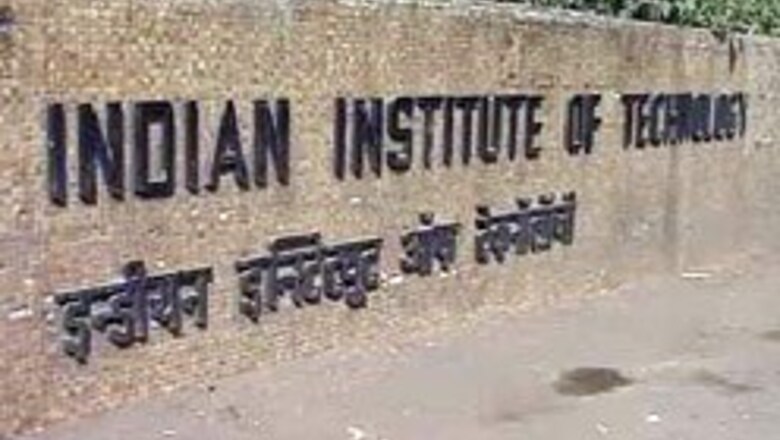
views
New Delhi: Are the prestigious Indian Institutes of Technology falling irreversibly into a deep abyss? Can these famed institutes survive the intense international attention and competition with outdated laboratories and worn-out infrastructure?
For decades, IIT alumni have done the nation proud, making them the hub of the brightest and the gifted.
But according to former IIT-Delhi Prof Shashi K Gulhati, the IIT system is under a massive strain that could lead to a big slump in their growth unless a solution is found, and fast.
Prof Gulhati, who has authored a book titled The IITs, Slumping or Soaring? recently, says that IITs run a big risk of heading down a 'deep abyss' never to rise again.
"I believe, the IITs are at a very critical juncture - they can slide down the hill or gear up to climb new peaks. I have spent almost my entire work life at IIT Delhi with short periods of absence when I was able to get a much wider exposure to educational and developmental issues both in India and abroad. I write this Book as an insider, who wants the IITs to flourish. I fear that unless we look at some facts head on and take some path breaking decisions, IITs will flounder,” Gulhati writes.
Interestingly, it’s not just the IITs that run the prospect of going kaput. According to the book, a study by McKincy and Co forecasts a nationwide shortage of faculty for the better engineering colleges to be around 50 per cent (nearly 5,000 faculty members)
Remuneration packages for the faculty also are low from industries working in core engineering fields. Even coaching centres which are only preparing students to be able to join the IITs pay more to their teachers than IITs, the book says.
IITs had great infrastructure when they were established. Although over the years inputs were made to modernise and renovate, obsolescence set in more rapidly in technological institutes, he says.
I have no idea. In other words it cannot be done. Apart from faculty, one needs laboratories, equipment, hostels, computer centres, workshops, libraries, technical staff etc.
Getting into IIT is every student's dream, but every aspirant's nightmare too. Is the selection process (syllabi etc) too taxing on the students?
It is not syllabi but the competition – too many aspirants, too few seats. We need more IITs but they cannot be set up overnight. We have been sleeping for too long. When you read the book, you will discover that major changes are necessary, in how we select students, how we attract more to choose a career as faculty members and how to fund and govern the IITs – only then will we move out of the present impasse.
Are the IIT well-equipped (in terms of lab equipment, faculty etc) enough to stand competition to institutes like, say MIT?
Far from it. For example, the learning resource material – books, periodicals, CDs, in all the seven IITs put together is far less than that of MIT.
PAGE_BREAK
“IITs, like all functioning organisms undergo constant change: new knowledge is generated - curricula are revised; laboratory equipment becomes obsolete - new equipment is procured; learning resources become outdated and are replaced with new ones; faculty members retire and new ones are recruited and so on. Much more important to recognise is that the nature of the student body is changing and the capacities and aspirations of the faculty are changing. Couple these changes with new expectations from IITs and clearly we have a situation where the dynamics become extremely complex. The need for careful thought and consideration followed by very consciously taking some crucial decisions is imperative,” he writes.
Another aspect that needs to be looked into is the attention that’s paid to the students of the institute. Doctors have the clout to attract attention and when they stop work, the hurt is immediate and visible.
Gulhati says that since non-cooperation from engineers and managers is not immediately life threatening, they can cry themselves hoarse and no one will blink an eyelash.
On recent controversy over increasing the seats to accommodate the OBCs and comparison of IITs with the Massachusetts Institute of Technology of the US - Gulhati is an MIT alumnus (class of 1961) - the author points out that the MIT does not admit 5,000 students every year. It only admits 1,000 undergraduates.
The book warns that increasing the student intake at the IITs without addressing the acute shortage of faculty and inadequate infrastructure - hostel rooms, student facilities, research labs etc - would only serve to diminish the world class standards achieved to date.
Gulhati rues that the problem is not limited just to the faculty and infrastructure. It begins right at the coaching stage.
"The coaching establishments do not educate, they break up the material into little modules that consist of various problem types. Understanding of the concepts, obviously, has nothing to do with it. Consequently it has been observed that coached students in recent years seemed less motivated to learn, he says.

















Comments
0 comment